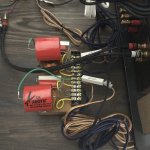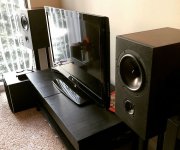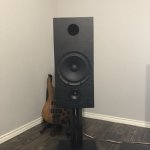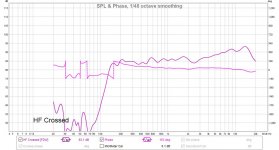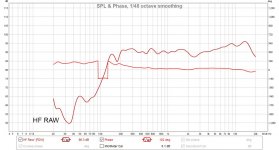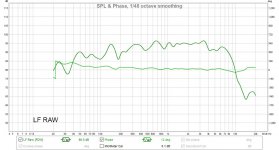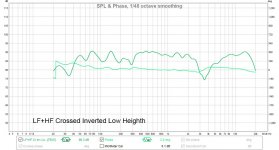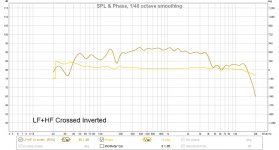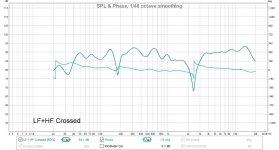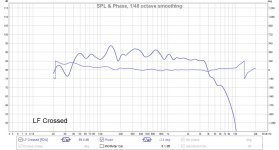Yeah i saw the PE caps, ebay seller accepted my offer and i got two of them for that price,
anyhow, i did a quick point to point and put the crossover together last night, i put 4.7uf and .51ohm in series and parallel with the woofer and it sounded abit bright so i added the 4 ohm padding in series w FR. didn't have time to listen to it for that long, but after a few hours here is my first impression :
compare to miniDSP, the highs was the first thing i noticed, it is better reproduced IMO, abit brighter which sounded closer to my JBLs, but better balanced, the imaging was the second thing I noticed, the imaging was defiantly better, left and right was better separated also, but the bass, bass is there, it is more powerful, no lack of performance there but it is not as tight as the miniDSP IMO, just slightly less punchier maybe, and overall I feel with miniDSP the instruments were slightly better separated.
I listened through my FH9 by the way since i m gonna retire my alpha until i build a new case with better cooling system.
overall i m very happy with the results and probably will not change this setup atleast for a while
thank you so much for your help and supports everyone, cheers
PS: I haven't done any measuring yet, will report back w any updates.
anyhow, i did a quick point to point and put the crossover together last night, i put 4.7uf and .51ohm in series and parallel with the woofer and it sounded abit bright so i added the 4 ohm padding in series w FR. didn't have time to listen to it for that long, but after a few hours here is my first impression :
compare to miniDSP, the highs was the first thing i noticed, it is better reproduced IMO, abit brighter which sounded closer to my JBLs, but better balanced, the imaging was the second thing I noticed, the imaging was defiantly better, left and right was better separated also, but the bass, bass is there, it is more powerful, no lack of performance there but it is not as tight as the miniDSP IMO, just slightly less punchier maybe, and overall I feel with miniDSP the instruments were slightly better separated.
I listened through my FH9 by the way since i m gonna retire my alpha until i build a new case with better cooling system.
overall i m very happy with the results and probably will not change this setup atleast for a while
thank you so much for your help and supports everyone, cheers

PS: I haven't done any measuring yet, will report back w any updates.
Attachments
Last edited:
Yeah i saw the PE caps, ebay seller accepted my offer and i got two of them for that price,
anyhow, i did a quick point to point and put the crossover together last night, i put 4.7uf and .51ohm in series and parallel with the woofer and it sounded abit bright so i added the 4 ohm padding in series w FR. didn't have time to listen to it for that long, but after a few hours here is my first impression :
compare to miniDSP, the highs was the first thing i noticed, it is better reproduced IMO, abit brighter which sounded closer to my JBLs, but better balanced, the imaging was the second thing I noticed, the imaging was defiantly better, left and right was better separated also, but the bass, bass is there, it is more powerful, no lack of performance there but it is not as tight as the miniDSP IMO, just slightly less punchier maybe, and overall I feel with miniDSP the instruments were slightly better separated.
I listened through my FH9 by the way since i m gonna retire my alpha until i build a new case with better cooling system.
overall i m very happy with the results and probably will not change this setup atleast for a while
thank you so much for your help and supports everyone, cheers
PS: I haven't done any measuring yet, will report back w any updates.
Hi Aatto. Interesting impressions. So you are comparing digital crossover vs. analog speaker level crossover? Identical slopes? Are you still powering the woofer and tweeter separately with this new crossover you built?
I considered getting a MiniDSP for its supreme flexibility but feel sort of paranoid about tampering with the original bits. But it gets you the benefit of limited bandwidth into each amp. Additional gain stages in active XOs don't appeal to me so much either. I've been researching PLLXOs...they seem unpopular but appeal to the minimalist in me.
Nice work. I expected you would need the padding on the 10F. The bass is punchier with the DSP probably because you equalized it?

Thanks X, I tried to avoid any EQing in miniDSP as far as i remember, maybe because the minidsp was Harsch XO it sounds "not much punchier" but tighter to me, i managed to listen to some more music and i still feel bass was a little bit tighter. what was your impression comparing miniDSP to your TP XO ?
Hi Aatto. Interesting impressions. So you are comparing digital crossover vs. analog speaker level crossover? Identical slopes? Are you still powering the woofer and tweeter separately with this new crossover you built?
I considered getting a MiniDSP for its supreme flexibility but feel sort of paranoid about tampering with the original bits. But it gets you the benefit of limited bandwidth into each amp. Additional gain stages in active XOs don't appeal to me so much either. I've been researching PLLXOs...they seem unpopular but appeal to the minimalist in me.
I didn't do a A/B comparison since I had to stop using my main alpha amp, just trying to compare my impressions and didn't measure anything yet, slobs would be different since this is a 1st order XO and miniDSP was Harsch XO, overall none of them sound much better or worse, they oth are very close sounding it's just the small details, and i like'm both and again i didn't have time to do critical listening, but beside my first impression, this passive XO sounds "easier" to my ear,.
miniDSP is definitely a good choice and worse the investment, and I would buy another one if anything happens to mine but will buy the HD version this time. hope this helps.
Last edited:
...no lack of performance there but it is not as tight as the miniDSP IMO, just slightly less punchier maybe, and overall I feel with miniDSP the instruments were slightly better separated...
In general think without any measurements data for slopes and global system curve we in guessing land, one guess could be lack of electric motion dampening you hear for that passive XO, in coil add some resistence that gradually increase up above F3 point and then add woofers own natural inductance because slope for first order is so wide being only 20dB down one decade above XO point, where for your Harsch miniDSP electronic filter you low pass with steeper 4th order filter so woofers own inductance have less influense up there plus woofer is direct wired to power amp.
Others can have different view for dampening of electric motion but for example in headphone land my experience is to get super realism into bass area then optimize for higest as possible dampening ratio. Cut heaphone cable as short as possible can sometimes be audioable and help, also seen some users that even prefer real power amps to feed their headphones.
In general think without any measurements data for slopes and global system curve we in guessing land, one guess could be lack of electric motion dampening you hear for that passive XO, in coil add some resistence that gradually increase up above F3 point and then add woofers own natural inductance because slope for first order is so wide being only 20dB down one decade above XO point, where for your Harsch miniDSP electronic filter you low pass with steeper 4th order filter so woofers own inductance have less influense up there plus woofer is direct wired to power amp.
Others can have different view for dampening of electric motion but for example in headphone land my experience is to get super realism into bass area then optimize for higest as possible dampening ratio. Cut heaphone cable as short as possible can sometimes be audioable and help, also seen some users that even prefer real power amps to feed their headphones.
Very Interesting information, thanks for sharing, i guess one of the advantages of electronic XO and bi-amping then.
but again it is not bad or even that noticeable to bother me, i m all happy with this
Hi Aatto,
Any luck with flipped woofer on top and sound cohesiveness?
yeah i did. is it me or it actually sounds tighter and better "reproduced" ?
It’s not just you, a measurement will show that the time alignment is better. The passive first order XO requires that the 10F be setback about 3in. By flipping it, assuming your listening position is at the woofer axis, the offset provides approximately the right delay.
interesting, hopefully i ll get to do some measurements soon. for now i have the speakers upside down, the woofer is not high enough to be at listening position but it still sound much better, like everything is better balanced and bass is beautiful. i really like the SBAs and i m already thinking about a new set of cabinets since it looks weird upside down  .
.
yours actually look goodIf you hadn’t put the big BR vent beneath (now above) the woofer it would look funny. For some reason, vents do look good as the top.
 for me the huge vent help a little but it still doesn't feel right
for me the huge vent help a little but it still doesn't feel right 
Attachments
Puzzled...
So I finally got a chance to measure the speaker w passive XO, and there s an insane DIP at 2K , at first I thought it is comb filtering but the dip is gone when i removed the crossover and measure the raw speaker in cabinet, the dip even exist when i flip the speaker, what do you think ?!

So I finally got a chance to measure the speaker w passive XO, and there s an insane DIP at 2K , at first I thought it is comb filtering but the dip is gone when i removed the crossover and measure the raw speaker in cabinet, the dip even exist when i flip the speaker, what do you think ?!
Attachments
If I look at the plots it looks like the woofer is flat well beyond 2kHz. Indeed looks like you have an even order higher XO and not a first order. The dip is indeed the two drivers. You have some work left to do on the XO. Looks like a larger inductor is needed to pull woofer lower.
Hi Aatto if target is 1st order then slopes looks way off.
HF section comments: HF RAW plot verse HF CROSSED are looking close to each other which they should not, HF CROSSED looks ala close to a 6th order 150Hz slope, from HF RAW we can predict/set a lowest possible target to about 950Hz because 1st order is supposed to be only 20dB down a decade below XO point.
LF section comments: LF CROSSED plot looks ala close to a 3rd order 3500Hz slope so low pass point is way too high and interfere with HF section, also phase looks weird in when amplitude fall off phase should also fall off to advance direction where plot actual show it goes in lacking direction.
General comments: Maybe use a amplitude scale set to about 50dB or up to 80dB coverage, and set phase scale from -180-360º up to +180-360º. Such settings will help look for interference reflections or bad microphone position, look for wherever there is ripple in amplitude or phase there shall also be ripple in the other one else there is interference finding place, also one can look for whereever a slope falls off its phase shall turn 90º per order in lacking direction for high pass slopes and in advanced direction for low pass slopes.
HF section comments: HF RAW plot verse HF CROSSED are looking close to each other which they should not, HF CROSSED looks ala close to a 6th order 150Hz slope, from HF RAW we can predict/set a lowest possible target to about 950Hz because 1st order is supposed to be only 20dB down a decade below XO point.
LF section comments: LF CROSSED plot looks ala close to a 3rd order 3500Hz slope so low pass point is way too high and interfere with HF section, also phase looks weird in when amplitude fall off phase should also fall off to advance direction where plot actual show it goes in lacking direction.
General comments: Maybe use a amplitude scale set to about 50dB or up to 80dB coverage, and set phase scale from -180-360º up to +180-360º. Such settings will help look for interference reflections or bad microphone position, look for wherever there is ripple in amplitude or phase there shall also be ripple in the other one else there is interference finding place, also one can look for whereever a slope falls off its phase shall turn 90º per order in lacking direction for high pass slopes and in advanced direction for low pass slopes.
- Home
- Loudspeakers
- Full Range
- 10F/8424 & RS225-8 FAST / WAW Ref Monitor
